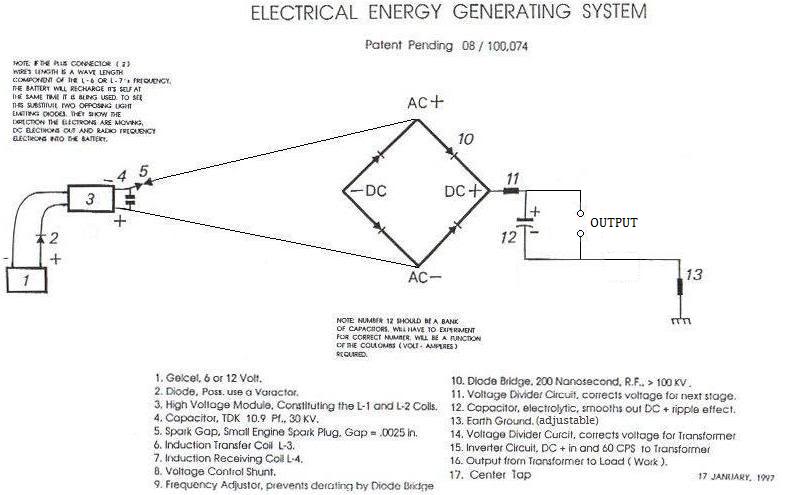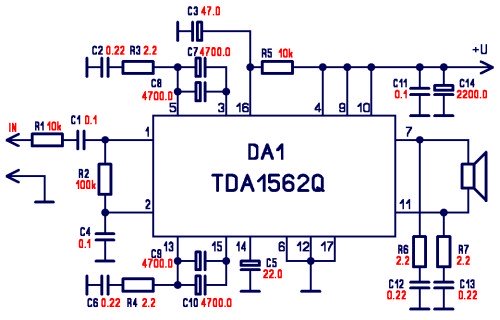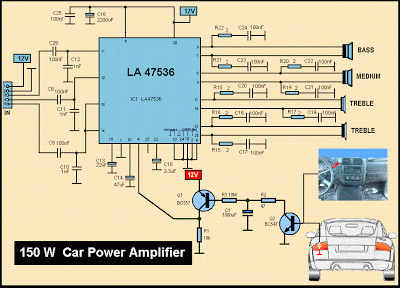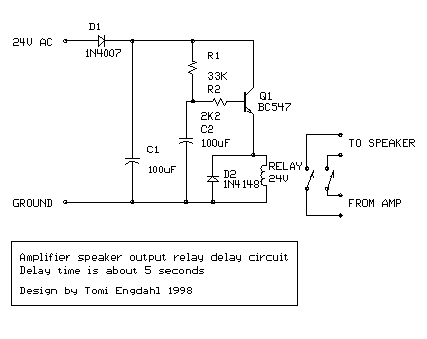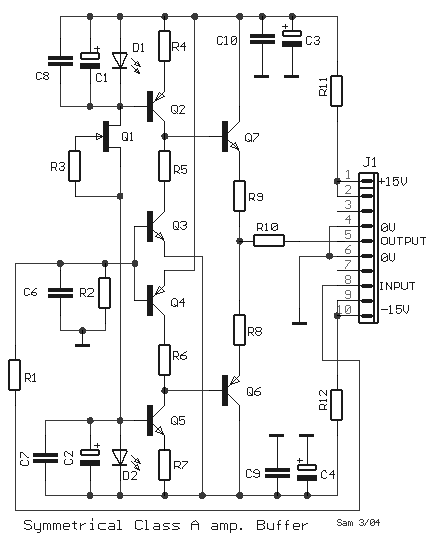
build good audio buffer
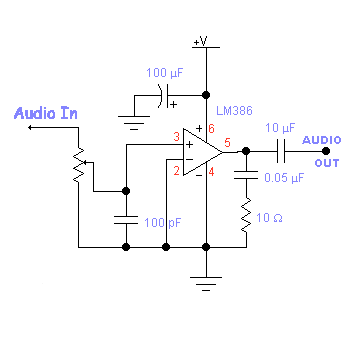
This circuit amplifies voice audio in the frequency range of 50 to 10,000 Hz with minimal distortion and is capable of driving a low impedance load of up to 16 ohms. It operates on a DC voltage of 6 to 15 volts and provides approximately 20 dB of gain. The design aims to create an inexpensive audio amplifier with a low parts count that is reliable and easy to construct. Components are available from Radio Shack. If the audio input is biased above ground (with audio floating on a voltage), a coupling capacitor must be installed in the "Audio In" lead to the potentiometer. The potentiometer can have a value ranging from 5 kΩ to 100 kΩ. A 100 pF capacitor is included to mitigate RF interference, making it suitable for environments with high RF levels. It is essential to include a 100 µF capacitor; otherwise, the circuit may oscillate. Many operational amplifier circuits struggle to drive low impedance loads effectively; however, this circuit can handle a load impedance of up to 16 ohms without requiring a load at that impedance. The output capacitor is a 10 µF non-polarized electrolytic capacitor, suitable for loads with impedances of up to 600 ohms. For loads with impedances of 100 ohms, the output capacitance should be increased to 100 µF, and for loads below 100 ohms (such as speakers), it should be raised to 1000 µF. The operating bandwidth ranges from 50 Hz to 10 kHz. Frequencies above 10 kHz may result in poor slew rate performance, leading to distortion; however, this bandwidth is acceptable for narrowband frequency modulation (NBFM) applications. The limitations of the slew rate can also help reduce susceptibility to RF interference. Additional audio amplification can be achieved by incorporating a feedback loop. For further examples, consult the Radio Shack parts substitution manual.
This audio amplifier circuit is designed with a focus on simplicity and effectiveness, making it a suitable option for various applications, including voice amplification and basic audio processing. The circuit typically employs an operational amplifier (op-amp) as the primary amplification element, which is known for its high gain and low noise characteristics.
The input stage of the circuit includes a coupling capacitor, which serves to block any DC offset present in the audio signal while allowing the AC audio signal to pass through. This ensures that the op-amp operates within its optimal input range. The choice of potentiometer value influences the gain and volume control of the amplifier, allowing for customization based on user preference.
The inclusion of a 100 pF capacitor at the input is critical in environments with high RF energy, as it acts as a filter, preventing unwanted high-frequency signals from interfering with the audio signal. The feedback loop, if added, can improve the linearity and overall performance of the amplifier by reducing distortion and increasing the bandwidth.
The output stage is designed to cater to a range of load impedances, making this amplifier versatile for different speaker types. The careful selection of output capacitor values ensures compatibility with various load conditions, thereby maximizing performance and preventing oscillation issues.
In summary, this circuit provides a balanced approach to audio amplification, combining reliability, ease of construction, and adaptability for diverse audio applications, particularly in settings where low distortion and low impedance drive capability are required.This circuit will amplify voice audio in the range of 50 to 10, 000 cycles with little distortion, and have the ability to drive a low impedance load to 16 ohms. The circuit will run from 6 to 15 vdc and give about 20 dB of gain. To build an inexpensive audio amplifier with little parts count that is very reliable and easy to build and implement.
P arts are available from Radio Shack. If the audio input is biased above ground (audio floats on a voltage) a coupling cap will need installed in the "Audio In" lead to the pot. The pot can be any value from 5 K to 100 K. The 100 pF helps eliminate RF bombardment, making it suitable for higher RF environments. Don`t forget the 100 uF cap or the circuit will oscillate. Many op-amp circuits don`t drive low impedance loads well, this circuit will handle a load impedance to about 16 ohms but doesn`t need to be loaded down to that impedance.
The output cap is a 10 uF non polarized electrolytic for impedance`s to 600 ohms. The output capacitance should be raised to 100 uF for impedance`s to 100 ohms and to 1000 uf for impedance`s below 100 ohms (speaker. ) Operating bandwidth is from 50 cycles to 10 kc. Over 10 kc and the unit suffers from poor slew rate, causing distortion, but for NBFM this bandwidth is acceptable.
Actually, for this purpose slew rate limitations work to our advantage as it helps make the amplifier less RF susceptible. Increased audio amplification can also be had with the addition of a feedback loop. Consult the RS parts substitution manual for examples. 🔗 External reference
This audio amplifier circuit is designed with a focus on simplicity and effectiveness, making it a suitable option for various applications, including voice amplification and basic audio processing. The circuit typically employs an operational amplifier (op-amp) as the primary amplification element, which is known for its high gain and low noise characteristics.
The input stage of the circuit includes a coupling capacitor, which serves to block any DC offset present in the audio signal while allowing the AC audio signal to pass through. This ensures that the op-amp operates within its optimal input range. The choice of potentiometer value influences the gain and volume control of the amplifier, allowing for customization based on user preference.
The inclusion of a 100 pF capacitor at the input is critical in environments with high RF energy, as it acts as a filter, preventing unwanted high-frequency signals from interfering with the audio signal. The feedback loop, if added, can improve the linearity and overall performance of the amplifier by reducing distortion and increasing the bandwidth.
The output stage is designed to cater to a range of load impedances, making this amplifier versatile for different speaker types. The careful selection of output capacitor values ensures compatibility with various load conditions, thereby maximizing performance and preventing oscillation issues.
In summary, this circuit provides a balanced approach to audio amplification, combining reliability, ease of construction, and adaptability for diverse audio applications, particularly in settings where low distortion and low impedance drive capability are required.This circuit will amplify voice audio in the range of 50 to 10, 000 cycles with little distortion, and have the ability to drive a low impedance load to 16 ohms. The circuit will run from 6 to 15 vdc and give about 20 dB of gain. To build an inexpensive audio amplifier with little parts count that is very reliable and easy to build and implement.
P arts are available from Radio Shack. If the audio input is biased above ground (audio floats on a voltage) a coupling cap will need installed in the "Audio In" lead to the pot. The pot can be any value from 5 K to 100 K. The 100 pF helps eliminate RF bombardment, making it suitable for higher RF environments. Don`t forget the 100 uF cap or the circuit will oscillate. Many op-amp circuits don`t drive low impedance loads well, this circuit will handle a load impedance to about 16 ohms but doesn`t need to be loaded down to that impedance.
The output cap is a 10 uF non polarized electrolytic for impedance`s to 600 ohms. The output capacitance should be raised to 100 uF for impedance`s to 100 ohms and to 1000 uf for impedance`s below 100 ohms (speaker. ) Operating bandwidth is from 50 cycles to 10 kc. Over 10 kc and the unit suffers from poor slew rate, causing distortion, but for NBFM this bandwidth is acceptable.
Actually, for this purpose slew rate limitations work to our advantage as it helps make the amplifier less RF susceptible. Increased audio amplification can also be had with the addition of a feedback loop. Consult the RS parts substitution manual for examples. 🔗 External reference

